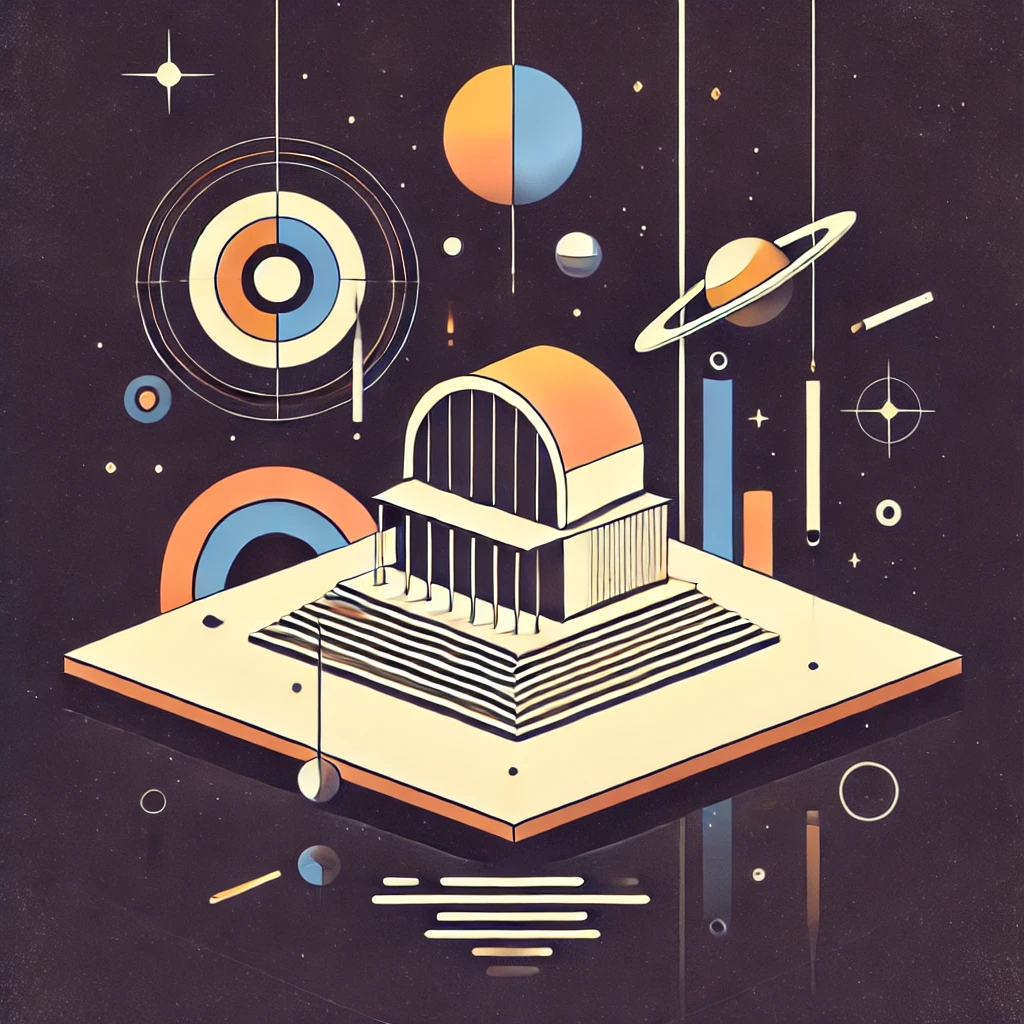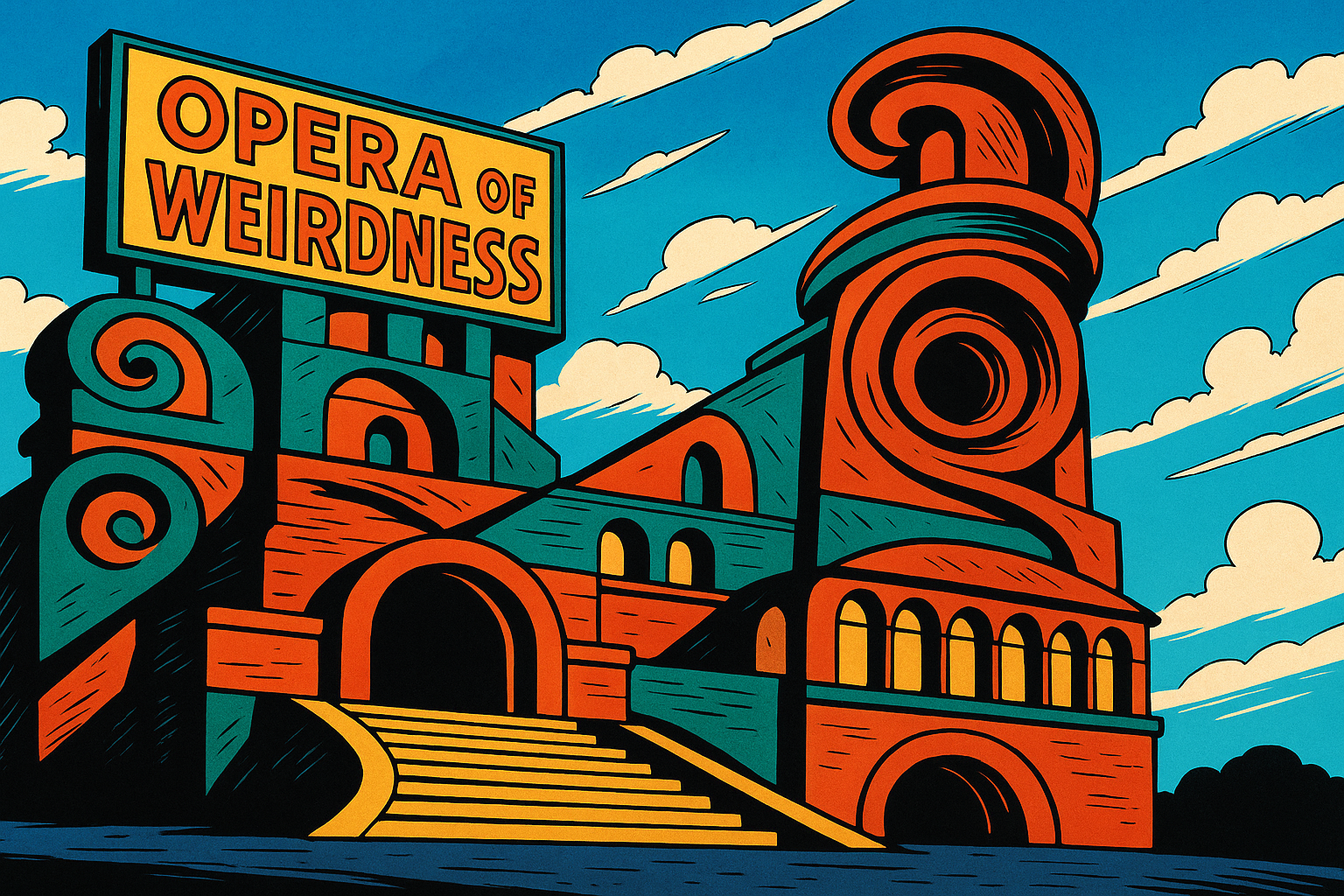
An early architectural concept of the opera which doesn't look like the final opera at all.
The Grand Tale of the Opera of Weirdness¶
In a galaxy not entirely unlike our own, where logic and reason are politely asked to wait outside, lies the enigmatic and utterly bewildering Opera of Weirdness. This architectural marvel—if one can use the word 'architectural' without being sued for misuse—is nestled on the edge of the Celestial Absurdity, a place where space itself has given up trying to make sense.
The Opera of Weirdness was constructed by the eccentric genius and part-time baker, Zebulon Quirkythrum III. After a long career of dabbling in quantum entanglement and making exceedingly good cakes, Zebulon decided to merge his two greatest passions: the incomprehensible nature of the universe and opera.
Rumors suggest that Zebulon was inspired by a dream in which he attended a performance by a choir of singing quarks accompanied by a neutron on the saxophone. He awoke with a start and a slightly singed eyebrow, convinced that the universe needed an opera house where the weird, the wonderful, and the utterly inexplicable could find a home.
The Construction of the Impossible¶
Building the Opera of Weirdness was no small feat, requiring the talents of the galaxy's most unconventional minds. Architects were hired not for their skills in design but for their ability to think at right angles to reality. The construction materials included dreamstone (which only exists when you aren't looking at it), paradoxium (a substance that defies explanation and gravity), and a generous helping of whimsy.
The resulting structure is a dizzying array of spiraling spires, floating platforms, and non-Euclidean corridors that twist and turn in ways that would make M.C. Escher ask for a seatbelt. The main auditorium is capable of seating an audience of thirty-seven billion (or just two, depending on how it feels that day) and boasts acoustics that can make even the sound of a pin dropping sound like an orchestral masterpiece.
The Performances and Curiosities¶
The Opera of Weirdness hosts performances that defy all conventional understanding of music. The inhabitants of Planet Kkefiehfw perform their traditional wedding tune, a piece that requires sixteen intergalactic bagpipes and a choir of sentient harmonicas. The 11th-dimensional music box creates melodies that can only be heard by beings who simultaneously exist and don't exist—a minor inconvenience for most patrons.
Other notable performances include the Cosmic Symphony of Nebulara, where the whispers of a distant nebula are converted into haunting melodies, and the Bioluminescent Ballad of the Deep Sea Dreamers, featuring the glowing synths and aquatic rhythms of Abyssalor. Each performance is a journey into the bizarre, the beautiful, and the brain-bendingly strange.
Also the Opera offers collected sound snippets like
The Audience¶
The audience at the Opera of Weirdness is as diverse as the performances themselves. Sentient clouds of gas share seats with time-traveling jellyfish, while interdimensional tourists marvel at the spectacle. It is said that attending a performance here can change your perception of reality forever—often quite literally.
The Legacy¶
The Opera of Weirdness stands as a testament to the boundless creativity and sheer madness of the universe. It is a place where the impossible becomes reality and where the boundaries of music are stretched, folded, and occasionally turned inside out.
Its mission is simple: to listen to the music the universe never meant to be heard.
The Researchers of the Opera¶
While the performances may dazzle and the architecture may confuse, it is the researchers of the Opera of Weirdness who ensure the continuum of cosmic curiosity never dries up.
Armed with resonant detectors, paradoxical recording devices, and the occasional bag of snacks, these brave souls venture into the strangest corners of existence. Their job: to locate, capture, and document the most bizarre and inexplicable sounds the universe has to offer.
From serenading plasma storms to the mournful songs of abandoned space stations, no soundscape is too remote, too ridiculous, or too dangerously melodious for the Opera’s Research Division.
Their findings enrich the Opera's vast archive of performances and allow future generations (or future hyper-intelligent cephalopods) to experience the full, unsettling majesty of universal weirdness.
It is often said among researchers: “If you can still describe what you heard, you weren't listening weirdly enough.”

The final three dimensional part of the opera. You would be correct to think why an opera at the other end of the universe says its name in Englisch, but it'll automatically displays the banner in a language the on-looker understands